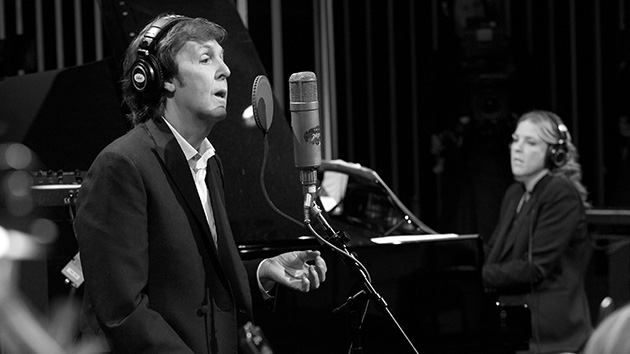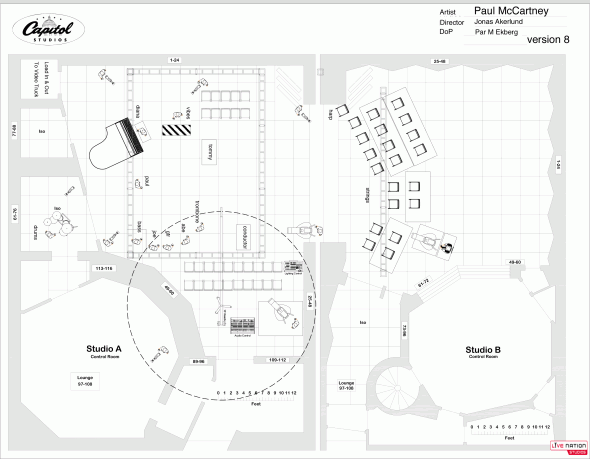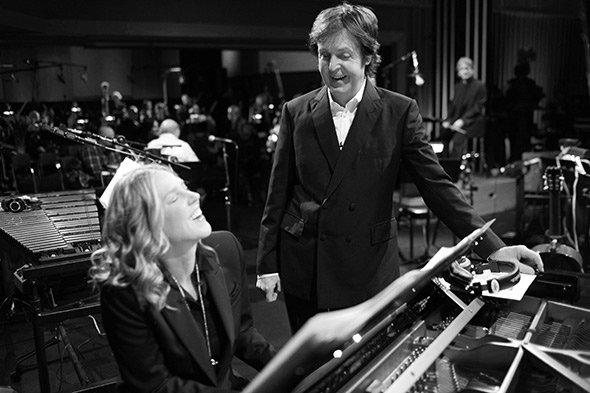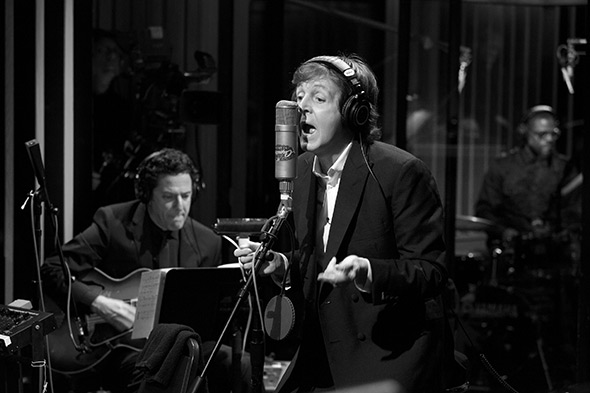How Director Jonas Ǻkerlund Used Remote Cams, GoPros, Rehearsal Footage and More to Recreate the Live Experience
When audiences first saw Paul McCartney on television in 1963, he was singing in black and white. 50 years later, he still is.
The former Beatle’s latest album of old standards, Kisses on the Bottom, which recently won a Grammy, was introduced to the world on February 9 last year via a live iTunes webcast. The feed was directed by renowned Swedish music video director Jonas Ǻkerlund, working with longtime DP Pär Ekberg. Ǻkerlund, who last worked with McCartney in 2002 (video for “Lonely Road”) also cut a different version for home video release, issued in November by Eagle Rock Entertainment, as well as an edit of that version, which was broadcast on PBS’s Great Performances.
The event was broadcast live, in coordination with Live Nation, from Capitol Studios in the historic Capitol Records Tower in Hollywood, outside of which, earlier in the day, McCartney had received a star on the Hollywood Walk of Fame. The album itself was recorded in that very studio, where such greats as label artists Frank Sinatra, Dean Martin and Nat “King” Cole, among others, had recorded many of their biggest hits.
Ǻkerlund was first brought aboard to help bring an enriched look to the live broadcast, but it was soon decided that a home video release of the show — a live performance of the album with an orchestra headed by jazz great Diana Krall — would also be issued. “We ended up recording all of the cameras for my edit, which I knew I’d be doing later,” he notes.
A Black-and-White Night
The director went with a black-and-white look, for both the broadcast and Blu-ray, out of a gut reaction to the music. “When I think of Capitol, I think of black and white,” he says. “Paul chose to record in that studio because so many of the original tracks were actually recorded there.”
Ǻkerlund wasn’t simply seeking to invoke a vintage feel. “That was never the point. I wanted it to look classy and beautiful — and, to me, there’s nothing as classy and beautiful as black and white. It gave the mood and feel that those songs deserved, that their history comes with.”
Seeking to assure there were plenty of candidate shots for both the live feed and later edit, Ǻkerlund and Live Nation set up plenty of cameras — in this case, ten Sony HDC-1500 HDs, eight with operators, and two with remote heads — not an easy task, given the size of the facility. “Our goal was to make as little a footprint as possible, but still get plenty of coverage,” explains Ekberg. “We said, ‘Let’s just blend in and let the musicians do their thing, just be a fly on the wall, which, somehow we were able to do.”
Click the camera layout diagram, above, to see a high-resolution version.
Capitol’s main room, Studio A, was set up with McCartney, surrounded by the jazz musicians (with drummer in an iso booth), as well as a small audience of invited guests spread about wherever there was room. A divider, which separates the slightly smaller Studio B, was opened, in which about 20 string players were placed.
Ekberg, his regular L.A.-based operators Josh Medak and Todd Heater, and a handful of others were placed strategically, to capture every angle of the performances and avoid being noticed. “The black and white actually helped us, because it enabled us to hide in the shadows,” the DP notes.
A jib arm, its base set near the entrance to the studio, was used to drop in and grab occasional details. The camera typically parked overhead of guest guitarist Joe Walsh to pick up the combo’s bass player. In addition, the team utilized a big handful of GoPro Hero 2 cameras, set in places where manual operation wouldn’t be possible. “We placed them all over — above the drummer in his iso booth, in the corridor leading to the parking lot to get Paul coming and going,” explains Ǻkerlund. Adds Ekberg, “They’re great, because you can just turn them on and walk away. The battery will die before you have to worry about running out of space on the storage cards.”
The handy, tiny rigs, tended to by camera op Gustaf Sandergard, were moved between the rehearsals and the actual performance, adding yet another set of images for the director to choose from — as was also the case with the Sonys, the director notes. “So instead of 10 angles to pick from in editing, I had 20.”
Insert closeups of the musicians were captured during rehearsals earlier in the day (and some a day earlier). Says Ekberg, “That allowed us to be more in the set, because there was no audience to obstruct.” Doing so allowed macro inserts of pianos and guitar solos, some of which were captured by Rob Witt (who has worked previously with Ǻkerlund and Ekberg as a second-unit DP), who was onhand for the rehearsal period. Notes Ǻkerlund, “I was then able to piece all of those together to give the appearance of a single take, even though that wasn’t always the case.”
The rehearsals also provided Ǻkerlund with plenty of material for interstitial segments, seen on the home video and PBS versions between songs, combined with interviews with musicians conducted by the director himself in McCartney’s dressing room prior to the show. “I just grabbed the musicians throughout the day. It was, like, ‘All right, that guy looks like he has five minutes – let’s pull him in,’” he laughs.
That material was augmented by shots captured by Heater, who was also dispatched throughout show day to capture moments like Paul’s star ceremony, as well as following the Beatle around the studio where appropriate. Other footage, of McCartney actually recording the album, both at Capitol and elsewhere (such as of guitarist Eric Clapton recording a solo in Abbey Road Studio Two in London, the very room in which he performed similar duties on The Beatles’ “While My Guitar Gently Weeps” in 1968), was provided by McCartney’s MPL Communications, shot by McCartney’s longtime assistant, John Hammel.
Photos courtesy Capitol Studios
It Takes a Team
Ǻkerlund directed the operators from a tent set up in the Capitol parking lot near the Tower’s back/studio entrance. With Live Nation in charge of getting the live feed out through iTunes, Ǻkerlund worked alongside the company’s live image director, Kerry Asmussen, and technical director, Wes Quon, to set and select shots for the iTunes feed. “Kerry and I worked well together,” the director notes. “I’m used to creating commercials and music videos – he and his team had plenty of experience to make something like this come off without a hitch.” Adds Ekberg, “They were actually sitting next to each other. We could hear their discussions in our headsets regarding upcoming shots.”
The director familiarized himself thoroughly with the album’s music and made note of the various solos performed by the musicians during rehearsals to prep for his direction to the operators. “There are no moving shots – it’s all static images here,” he explains. “We want the camera to already be on Diana Krall as she begins her solo, not seen making its way to her as she starts.”
Ǻkerlund had to plan and direct shots for the live broadcast as well as for the home video release, to be edited in the future. “In a sense, it was like doing two projects at the same time,” he explains. “The live edit is really a very different film from the version I did later. It’s impossible to work with that type of precision on a live feed. It’s a much slower cut. You don’t want to take any risks when you do live edits. You stay on shots and go slowly to the next one, which is a very different way of thinking.”
The black-and-white color timing was done twice on location — once with Live Nation Digital Imaging Technician (DIT) David Kekone for the live feed, and again by Ǻkerlund’s L.A.-based DITs, Lee Arakel and Joe Hedge, to create look-up tables for later use during final color-correction. “I told them what I wanted, and they came up with a couple of suggestions, one of which I chose,” the director states. “I like to push the contrast, to make sure that the black is black and the white is white.”
Photos courtesy Capitol Studios
“We wanted it contrasty, sort of moody,” notes Ekberg, “but still have all the people look good — not crush it so much that you can’t see the audience. We wanted to have a feeling that they were there, even if you don’t see them much.” Ǻkerlund did final grading with colorist Pana Argueta at UNCLE Berlin in Germany later in the year, following completion of the film and online editing at jumP in New York City.
Ǻkerlund worked alongside longtime editor Luis Moreno, who cut the film on on Final Cut Pro. "We actually started on it right after the show, but we extended the schedule because the project was actually pretty ambitious.”
The director treated each song to its own style. For instance, the handwritten lyrics to “The Glory of Love” are shown onscreen as McCartney sings them, and Paul’s family photos add a personal touch to “Home.”
“I wanted each song to have its own style,” Ǻkerlund notes. “I tried to come up with something special for each track. I actually asked Paul to write out the lyrics for ‘Glory of Love.’ That’s his own handwriting. And the photos from Paul and his brother, Mike, were just fantastic.”
He was also keen to leave in the type of thing one might expect on a live broadcast, such as several false starts to “My Very Good Friend the Milkman,” in which McCartney doesn’t quite hit the mark on his whistling intro the way he wanted to until after a few tries, stopping the band until he got it right. (Several false starts that went out live were trimmed down to an interesting handful for home video and excised completely for the PBS broadcast, for time’s sake.) “It’s essentially live TV. Stuff happens,” the director explains. “That’s something I wanted to show, because it shows the audience the process. I showed it to Paul after editing, and he laughed. He loved it. So we kept it in.”
The TV edit, while leaving song performances completely intact, also trimmed many of the interstitial pieces Ǻkerlund created, one of which provides an interesting history of the Capitol Tower and studio, for which Ǻkerlund made ample use of Capitol’s own archives. “The whole studio staff at Capitol was really great — incredibly helpful.”
The resulting program allows the audience to observe McCartney presenting an unusual performance, unlike his large-scale concert performances. Instead, it's intimate, like a loosen-your-tie-and-have-a-drink nightclub performance of old. “A project like this is very special,” Ǻkerlund says. “It’s the kind of thing you hope will live forever. I’m very proud of it, and I know Paul is, too.”
Did you enjoy this article? Sign up to receive the StudioDaily Fix eletter containing the latest stories, including news, videos, interviews, reviews and more.













Leave a Reply